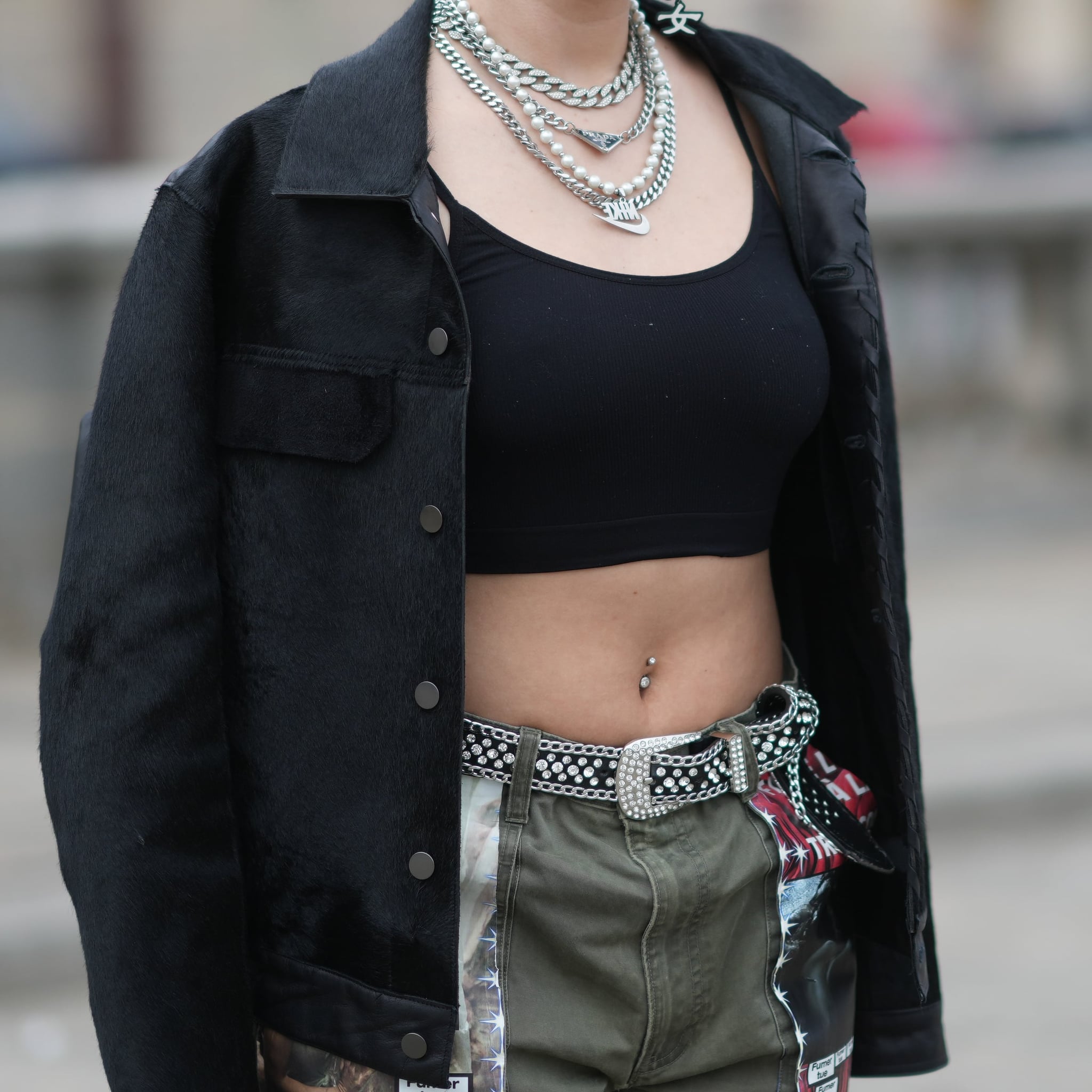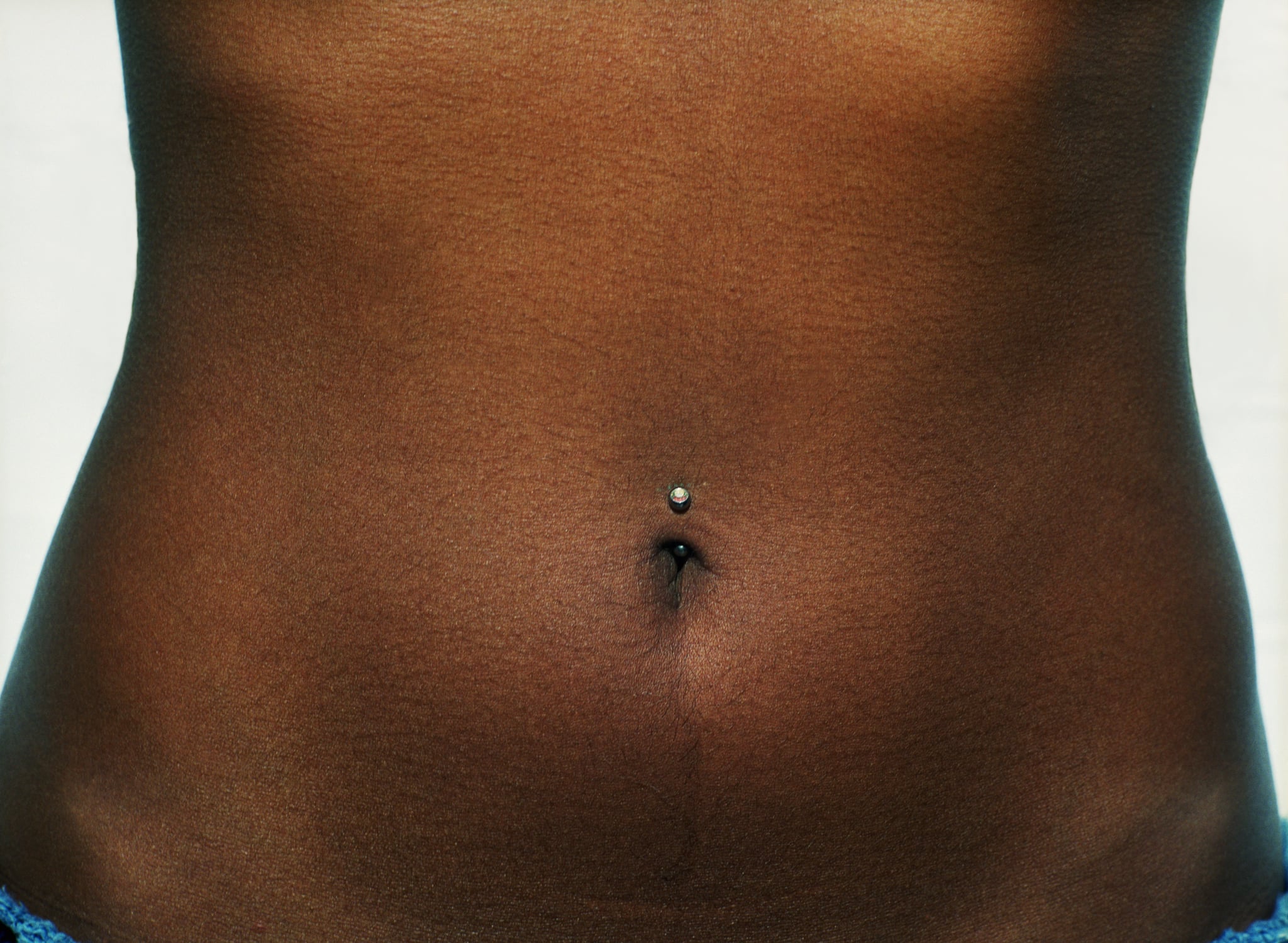
- Belly button piercings have risen in popularity in recent months.
- The placement of a navel piercing can be on the top or bottom skin.
- An expert breaks down everything to know before getting the piercing, from the pain level to the cost to the after care.
From the return of low-rise jeans to chunky highlights, 2000s beauty trends are making a grand return this year. Body modifications are no exception, of course, and this is especially true when it comes to piercings. More specifically: belly button piercings.
For the uninitiated, this placement of belly bling was huge in the early aughts, with stars like Britney Spears and Beyonce leading the charge. Still, if you’re considering hopping on this what’s-old-is-new-again bandwagon, there are a few things to keep in mind before you make your appointment. To help break it down, we asked Joshua David Harris, a piercer at 108 Studios to walk us through the process. Keep reading for the answers to all your burning belly button piercing questions.
First, How to Choose Your Piercer
Before you get any holes in your body, make sure you’re feeling good about your piercer. Harris recommends you look for a piercer who will take the time with you, answer your questions, and make you feel comfortable above all else. “Trust your gut,” he says. “If you go into a shop and get weird vibes, go somewhere else. You don’t have to do it just because you are there. Your body, your choice.”
How Much Does a Navel Piercing Cost?
Every shop is different, but you can usually expect to pay a piercing service fee plus the cost of jewelry. The material of the piercing jewelry is really what’s going to determine the price: for instance, solid-gold barbells can be significantly more expensive than surgical steel or other metals. To get an idea of what you’re looking at, 108 Studios charges $45 for the first hole, a simple solid-gold hoop starts at $70, and solid-gold barbells start at $220.
You also want to consider what the jewelry is made of; you should only get pierced with a hypoallergenic material, like gold, surgical steel, or titanium. Harris, for example, only uses 18K and 14K yellow gold, 14K rose gold, and 14K white gold. Ask your piercer if you aren’t sure what the jewelry is made of.
What to Expect at Your Appointment
First, your piercer will take a look at your navel and talk to you about the best route in terms of jewelry and placement. Things like the shape of your navel — meaning an innie or an outie, or even the amount of skin you have to work with — will guide the type of jewelry you should be pierced with. Harris also says there are some people who might want to reconsider getting their belly button pierced at all, but it’s something you can talk about at your appointment. “It’s a case-by-case basis,” he says. “I’d rather not do it if I think it’s going to cause you problems or your body will just end up rejecting it.”
In terms of what jewelry works best for the navel area, Harris recommends starting with a curved barbell for easier healing. “You want some breathing room to allow for swelling in a new piercing.” Once it’s healed and feeling good, he says a small hoop can be swapped in to fit “nice and snug.”
Once you’ve landed on the jewelry, it’s time to get down to business. Your piercer will look at where your skin naturally falls when you’re comfortably standing and make a tiny mark where the piercing will sit. Don’t be shy about saying something if you don’t like the placement. It’s better to speak up now rather than after the piercing is done.
When you’re ready to go, your piercer will have you lie down on your back and place a clamp around your navel to keep everything lined up and set up. It feels a little tight but shouldn’t hurt. Most piercers today use a hollow needle to pierce this area, done by hand. “The needle seems a little scary, but it’s healthier on the tissue and allows us to get more precise with the piercing,” Harris says. “It’s also used to connect to the jewelry and guide it in. The gun pierces you with the jewelry by forcing it through the tissue.”
What to Wear to Your Piercing Appointment
The question of what to wear to your appointment might seem obvious, but it’s easily overlooked. Harris suggests you wear “something comfortable and not too tight. Pants or shorts that do not lay across your navel and a shirt are best. Anything with easy access to that area. Dresses or onesies are a little trickier for obvious reasons.”
How Painful Is a Belly-Button Piercing?
While pain is relative and based on each person’s individual pain tolerance, getting a needle pushed through your skin is never going to be pleasant. Still, many people say it’s not nearly as painful as some of the piercings in areas with thicker cartilage. The most uncomfortable part tends to be the few seconds it takes to thread the piece of jewelry through the hollow needle.

What Is the Aftercare For a Navel Piercing?
Harris explained that aftercare is actually quite easy for a new belly-button piercing. He recommends cleaning it twice daily with some fragrance-free soap and water. Do your best to leave it alone, and don’t overclean or touch it with dirty hands. Until it’s fully healed, you want to be careful of snagging it on a towel or rubbing it with your clothes (tread lightly around high-waisted jeans).
“Try not to do anything that has you laying on it or putting a lot of pressure on it,” Harris says. “Be careful with those loofahs in the shower, too. If it’s comfortable enough for you to work out, then it should be OK. Just be mindful of it.”
How Long Does a New Navel Piercing Take to Heal?
Keep in mind that everyone heals differently, and some people’s bodies react differently to a piercing than others. Generally, the healing process takes between three and six months, but it could take longer. “I tell clients to wait a minimum of three months before changing out the jewelry, but waiting longer is always better,” Harris says. “When you want to change it out, check in with your piercer to see if it’s actually ready. Don’t get impatient and change it too soon. It could cause problems you won’t want to deal with in the long run.”
One common concern is getting “the bump” near your navel area during the healing process. The main thing to know: don’t freak out. “The bumps are usually temporary, cosmetic, and will eventually clear up with a little extra care and caution,” Harris says. “Normally, I have clients start with a daily hot compress to the area, which helps draw out the irritation and shrink the bumps down. If that’s not working, sometimes changing up the jewelry you have in can help.” Before taking drastic steps like taking out the jewelry yourself, let your piercer take a look and give you a plan of action.
Harris says that oftentimes, irritation is confused with infection. “More often than not, piercings become irritated, not infected. If you are having concerns about what is happening with your piercing, it’s always best to go see your piercer in person so they see exactly what is going on. Everything is fixable, so there’s nothing to stress about if your piercing gets irritated.” Your piercer can let you know if you really do have an infection and advise when to see a doctor.
If you have a closed hole from a previous piercing, the aftercare looks a little different. “If it can be reopened, it’s pretty easy to do, and you don’t have to deal with all the aftercare of a new piercing,” Harris says. “You can also put in a more fitted piece of jewelry right away.”
Source: Read Full Article
